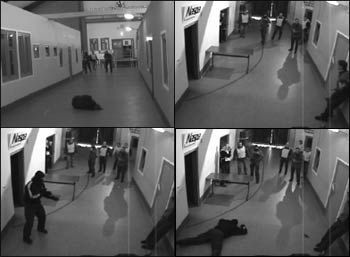By Christopher Heim, Eckhard Niebergall and Dietmar Schmidtbleicher
From Polizeitrainer Magazin (Germany)
It was 2.30 a.m. In search of a fleeing suspect, Officer J. had parked his car and was standing in a dark backyard, his service weapon drawn. He was contemplating going back to his vehicle for his flashlight when suddenly he saw a shadow move about five yards in front of him. At that exact moment he was blinded by a flash of light that was immediately followed by a loud noise.
When questioned afterwards, Officer J. could only recall raising his arms to protect himself from the light. It was only when he counted the shells in his gun that he noticed that the loud noise he had heard after the flash had been his own gun going off. Thankfully no one had been injured – the projectile had hit a shed on the other side of the yard. The shadow that had startled Officer J. turned out to have been a 14-year old boy, who testified that he had always wanted to take a photograph of “a policeman in action” (first published in the German Polizeitrainer-Magazin 2/1998, page 10).
Over the past few years’ incidents of involuntary discharges of police firearms – as described above – have been a cause of growing concern throughout Germany. In the 1990s several police officers were prosecuted for injuring or even killing suspects by involuntarily discharging their weapons in the line of duty. Since 1999, at least four more suspects have been killed by involuntary discharges from police firearms. In 2001, a policeman accidentally killed his colleague when his weapon went off as they left a building after they had searched it for intruders. In the United States of America, similar incidents have been reported: in an article published in 1997, Edward Tully, currently Executive Director of NEIA, lists eleven cases of officers killing or injuring suspects, colleagues or even themselves by unintentionally discharging their firearm. Even earlier, Geller and Scott (1992) report 62 unintentional discharges by NYPD officers in 1990 alone. In a more recent article published in the Washington Post in 2002, O’Brien describes three unintentional discharges in Onondaga County (NY), one of these happening to one of the most experienced officers in the department: a firearms instructor unintentionally fired a hole through a classroom wall while teaching a class how to remove a weapon from the holster.
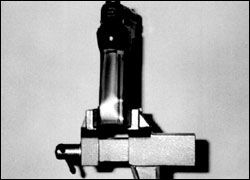 Figure 1: Attachment of the force sensing resistors to the back of the hand-stock. |
Not all incidents of involuntary firearms discharges are subject to court cases; often enough, the bullet will – luckily – go astray and for example “get stuck in the door frame”, not harming anyone. However, in some incidents – at least in Germany – police officers have been sentenced as a result of such unfortunate events. For example, in 1995 three police officers were called to investigate a possible burglary at three a.m. in the morning. One officer stood alone with his weapon drawn in a dark backyard while two colleagues entered the house to search for the intruder. When the suspect saw the policemen entering the building, he climbed out of a window on the second floor and tried to slide down the drain pipe. Unfortunately for him, the drain pipe gave way and he fell from about five metres height. The officer, startled by the loud sound, looked up to see a shadow falling towards him and raised his hands in protection…the bullet passed through the suspect’s neck while he was still in mid-air. The officer was sentenced to a fine of 8.000,- Deutschmarks because of negligent homicide.
This court sentence is an example of consequences officers had to face only a dozen years ago when charged with injuring or killing suspects (or innocent bystanders) by involuntarily discharging their firearms. Due to the dearth of information about the mechanisms that may underlie such incidents, prosecutors and defence lawyers alike were confronted with the same question: is it indeed possible to involuntarily overcome the trigger pull (which usually lies between four and six pounds) of a standard police weapon? In an effort to find answers to this question Professor Dr. Roger Enoka, one of the most renowned sports physiologists and director of the Human Performance Research Laboratories in Arizona (USA), was invited to testify in a court case held in Frankfurt, Germany in 1995. Professor Enoka was one of the first researchers to examine the circumstances under which involuntary firearms discharges may occur. Based on a review of relevant literature he not only confirmed the possibility of involuntarily discharging a firearm, but also offered explanations as to their possible causes: involuntary discharges, Enoka proposed, may result from involuntary muscle contractions in the hand holding a firearm. All human movements (and thus also the flexion of the index finger when pulling a trigger), so Enoka, are based on muscle contractions, which are generally caused by a direct command from the brain (known as a voluntary contraction). However, muscles can also be activated by signals that arise from other locations within the nervous system besides the brain, and such activation may produce a muscle contraction that is not the result of a conscious decision. This is especially likely to occur when the human body has to react quickly to an unexpected incident, for instance (as is illustrated at the outset) a light flashing directly in front of an individual. According to Enoka, there are three scenarios that may elicit involuntary muscle contractions that are sufficiently strong to bring about the involuntary discharge of a firearm: sympathetic contractions, loss of balance and startle reaction.
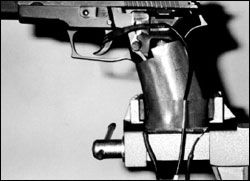 Figure 2: Attachment of the force sensing resistors on the trigger and fastening of the sensors with tape. |
The term sympathetic contraction refers to the fact that an involuntary contraction may occur in the muscles of one limb when the same muscles in the other limb are performing an intended forceful action. In physiology literature this effect is known as a mirror movement, with the intensity of the sympathetic contraction depending on the amount of force exerted during the intended action. In policing, a common situation that may evoke such a sympathetic contraction would be, for example, a law enforcement officer attempting to restrain a struggling suspect with one hand while holding a handgun in the other.
The second scenario described by Enoka involves loss of balance. When balance is disturbed the human body evokes rapid involuntary contractions to return itself to a position of equilibrium. Thereby the involuntary contractions used to prevent a fall depend on the options available to counteract the disturbance of balance. Usually, compensatory movements following gait perturbations primarily involve correcting movements of the lower limbs to keep the body in balance, whereas movements of the arms are restricted to their extension forwards as a safeguard to counter an eventual fall. When an individual is holding a handle for support, there is, however, a tendency to use the arm muscles to maintain balance rather than the leg muscles. Under such circumstances the focal point of automatic postural activity is any contact point an individual has with his or her surroundings. In other words, if an individual’s posture is disturbed while grasping an object, for instance a handgun, he or she is likely to grasp it more forcefully.
Startle reaction, the third scenario identified by Enoka, is a whole-body reflex-like response to an unexpected stimulus, possibly a loud noise. It evokes rapid involuntary contractions that begin with the blink of an eye and spread to all muscles throughout the body. The reaction of the hands occurs less than 200ms after the stimulus and leads to individuals clenching their fists. Enoka concludes: “Accordingly, an officer who is startled by a loud, unexpected noise while searching for a suspect with his weapon drawn would surely increase the grip force on the weapon, perhaps enough to cause an involuntary discharge.”
 Figure 3: Example of a force-time-curve registered for a participating officer in study one. From top to bottom: force exerted on the back of the hand-stock, force exerted on the trigger. The y-axis shows the electrical signal (in volts) registered by the force sensors, the x-axis shows the time-line of the trial. |
However, no matter how feasible Enoka’s explanations may have been and no matter to what extent they were corroborated by analyses of involuntary discharges (for instance by Tully, see above), they were not able to unequivocally answer the central question asked in German courtrooms: is it indeed possible to involuntarily overcome the trigger pull of a standard police weapon? The judges criticised that there was no empirical evidence that supported Enoka’s theories, namely that involuntary muscle contractions brought about by neurological connections between limbs may indeed result in sufficient force being produced in the hand carrying a firearm to involuntarily overcome the trigger pull of a standard police service weapon. Moreover, there was a second question left unanswered: German police regulations unambiguously stipulate that when holding a gun, the index finger has always to be placed outside the trigger guard and may only be placed on the trigger when a conscious decision to fire has been taken. If these regulations were adhered to, incidents of involuntary discharge should be impossible.
 Figures 4: Trial settings in Study two. |
During his stay in Germany, Professor Enoka met with Eckhard Niebergall, president of the German Police Trainers Association (Polizeitrainer in Deutschland e.V.) and Professor Dr. Dietmar Schmidtbleicher, also a sports physiologist like Enoka and Head of the Department of Human Movement Science at the University of Frankfurt. At this time, Professor Schmidtbleicher’s department possessed one of the few laboratories in Germany that had the means of empirically validating the theories proposed by Enoka. Thus, with the aim of setting the jurisdiction regarding cases of involuntary firearms discharge on solid grounds, a research programme was initiated.
For their research, Professor Schmidtbleicher’s team fixed force sensing resistors to the hand-stock and trigger of a pistol (see Figures 1 and 2), and asked 34 randomly chosen police officers to react to a set case. During the trial the force sensors implemented in the trial apparatus made it possible to register any changes in pressure exerted on the firearm by the participating officers. The results suggested that, despite the above mentioned regulations stipulating to keep the index finger away from the trigger at all times unless they are ready to fire, police officers may – in certain situations – not only make contact with the trigger, but that this contact may even go unnoticed: despite force readings registered by the sensors during the trial and video footage of the incidents clearly showing that seven of the 34 participating officers (20.6%) had laid their index finger on the trigger at some point during the scenario, all participants, when questioned after the trial, maintained that they had not made contact with the trigger. Moreover, none of the participating officers could give any particulars about the force exerted on the hand stock, even though a noticeable increase in the amount of pressure exerted was registered (see Figure 3).
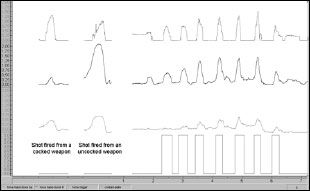 Figure 5: Exemplary force-time-curve registered in the trial “jump” in comparison to the forces reached when actually firing the weapon. In this trial, participants performed six to seven successive jumps on a contact platform (force plate) while holding the prepared weapon. From top to bottom: force exerted on the trigger, force exerted on the front of the hand-stock, force exerted on the back of the hand-stock. The bottom graph shows the trigger signal, marking the contact with the force plate. |
With the knowledge that police officers may indeed nonconsciously make contact with the trigger during critical incident situations in mind, Professor Schmidtbleicher’s team turned their attention to empirically validating the assumptions made by Enoka, namely that involuntary discharges may be the result of unintended muscle contractions. For this study, 25 participants (13 women and 12 men between 21 and 39 years of age) were asked to perform a series of trials that necessitated specific movements of only one limb while holding a pistol fixed with force sensing resistors (see Figure 4). These sensors recorded changes in the pressure exerted on the firearm during the trial, making it possible to unequivocally determine if and to what extend activity in particular limbs may lead to an increase in the pressure exerted on the gun. The results clearly indicate that motor activity in other limbs may indeed lead to a significant increase in the force exerted on a firearm (see Figures 5 and 6) and that the resulting pressure on the trigger can be sufficient to (involuntarily) overcome the trigger pull of most police weapons (see Table 1). These findings not only validated the theories proposed by Enoka, but, in doing so, also provided scientific evidence of the fact that it is indeed possible for police officers to involuntarily discharge a weapon in the line of duty.
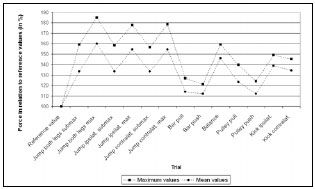 Figure 6: Mean force values for all participants registered at the back of the hand stock in the different trials in comparison to holding the gun when not performing a trial (reference value). |
Throughout Germany, at least, the findings had a significant impact on legal proceedings: in 1999, based on the statements made by Professor Schmidtbleicher and Eckhard Niebergall, a judge was prepared, for the first time, to consider the possibility of an involuntary discharge as mitigating circumstances for an officer impeached of killing a suspect when his gun went off during a struggle.
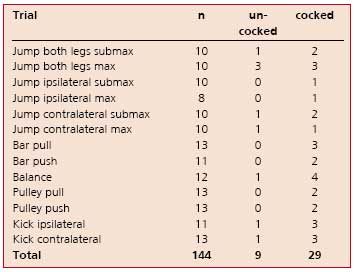 Table 1: Number of participants exceeding the pistol’s release values for a cocked (trigger pull of 22 Newton) and uncocked (trigger pull of 56.9 Newton) weapon during the trials. At each trial the number of participants exceeding the release values at least once was counted as one, irrespective of the number of times a participant exceeded his personal release value. The differing number of participants (n) in each trial results from the fact that some participants took their finger of the trigger during the trial. Thus, the table reads as follows: in the trial “jumping on both legs submaximally“, 10 (n) participants kept their finger on the trigger, of which one exerted enough pressure on the trigger to release a shot from an uncocked weapon, one further participant (adding up to two) exerted enough pressure to release a shot from a cocked weapon. |
These important findings have resulted in a continued scientific interest, in both involuntary discharges and also in policing more generally. Thus, an exceptionally well resourced collaborative study between the police force of the German state Hesse and the University of Frankfurt is currently underway which intends to shed further light onto factors of gunhandling during everyday police work. Aims of the study are not only to gain an even better understanding of the mechanisms that may lead to involuntary discharges, but also to get a better insight into tactical situations in general: are there – apart from the factors described by Enoka and empirically validated by Professor Schmidtbleicher’s team – further factors that may increase the likelihood of involuntarily firing a gun? For example, what roles do cognition and perception play in cases of involuntary firearms discharge? More generally speaking: how do police officers perceive tactical situations, and to what extent are they limited in their ability to make use of sensory information appropriately? Moreover, do work experience, training experience and/or rank have any influence how officers cope with dangerous situations or how officers handle their firearms – and if so, in what way?
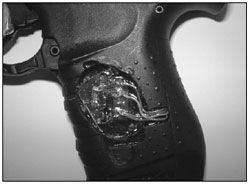 Figure 7: Force sensing resistors embedded in the hand-stock. The sensors were subsequently disguised. |
For this study, a unique measuring device was constructed by installing a number of sensors into a standard service weapon (see Figure 7 for an example). This weapon enables the scientists to register in real time the forces exerted on the hand-stock and the trigger, as well as record the current position of the trigger (i.e. the extent to which it has been pulled) and the horizontal and vertical position of the weapon (the direction, in which the weapon is aiming). Equipped with this measuring device, 260 officers of different ages, gender, ranks and with different years of service and training experiences took part in a training scenario in the Hesse State Police Academy in Wiesbaden, Germany. In this training scenario (see the case description on page 20), participating officers were individually confronted with a set case with an identical number of suspects, together with comparable auditory disturbances. During the training simulation the sensors installed in the weapon recorded the pressure participants exerted on the hand-stock, whether they made contact with the trigger with their index finger and, if so, to which degree the trigger was pulled and in which position the weapon was held. Additionally, participants’ heart rates were monitored. All data were transferred to a computer by means of a telemetrical device (see Figure 8). Additionally, the situation was recorded with cameras from three different angles, allowing not only for retrospective comparison of the recorded data with the actual event, but also for an evaluation of the course of action each participant took during the setting. After going through the scenario participants were asked to fill in a questionnaire relating to their subjective experience of the operation.
First results of this study – based on the analysis of 66 participating officers – have been presented at the European Police Trainers Conference in Nuremberg, Germany (March 2006) and Jane’s Annual Less-Lethal Weapons Conference in Leeds, UK (October 2006). These results are subsequently summarised.
 Figure 8: Example of the measurement values registered for a participating officer. From top to bottom: force exerted on the trigger, force exerted on the hand-stock, current position of the trigger, vertical and horizontal movement of the weapon, participant’s heart rate, trigger signal, time-line in seconds. |
The 66 officers analysed to date can be divided into four different groups:
- 14 entrant officers who had started their training three weeks prior to the trial and thus had no weapons training whatsoever (mean age 21.7 ± 2.9 years)
- 19 officers in training at the end of their second year in the police school (mean age 21.3 ± 2.3 years)
- 22 regular officers on patrol duty (mean age 37.6 ± 8.9 years, mean duration on the force 17.6 ± 10.7)
- 11 officers belonging to Special Forces (SEK, MEK, PS) (mean age 30.2 ± 3.5 years, mean duration on the force 8.6 ± 4.8 years)
The first noticeable result is that in all groups a majority of officers placed their index finger inside the trigger guard at some point in the scenario without actually firing the gun (a few officers even had permanent contact with the trigger during the full length of the trial), thus violating police regulations to keep the finger off the trigger until a decision to fire has been taken, with the highest proportion – perhaps unsurprisingly – being reached in the group of the entrant officers who had not yet received any weapons training (see Figure 9). Analysis of the questionnaires filled out by the officers after the trial also confirmed that this violation of police rules appeared to occur nonconsciously: only very few participants were able to correctly give information about the position of their index finger during the trial (Figure 10 exemplarily shows the answers given by the group of officers on patrol duty).
Even though only about a quarter of the data from participating officers have been analysed to date, the results already offer new insights into the occurrence of incidents of involuntary discharge. During the scenario, four of the 66 participating officers (one out of each “trainee” group and two out of the group of officers on patrol duty) fired their weapon at a point in which there was no obvious threat either for themselves or for the lives of others: in all four cases the officers shot just after the second suspect had stepped out of the bank but before he had pulled his weapon. In all four cases the officers stood at least five metres away from either suspect at the time of the shooting, and in all four cases the officers shot in an immediate response (less than 300ms after) to the startle stimulus (the gun being fired by a trainer behind his or her back). Furthermore, in all four cases the officers had their index fingers lying on the trigger immediately prior to the startle stimulus occurring.
It is unclear, however, what exactly caused the officers to fire since none of the three scenarios described by Enoka (sympathetic contractions, loss of balance or the physiological human startle reaction) appear to be applicable to the situation: none of the participants lost their balance at any time in the scenario, at no time did the officers forcefully use any other limb when holding the gun in their hand and in only one of the four cases (and even then only after repeatedly viewing the videotape of the scene in slow motion) could the whole-body reflex-like response in reaction to the unexpected stimulus (the shot fired behind the back of the officer) described by Enoka be found.
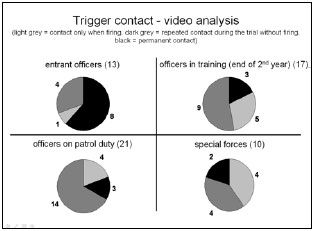 Figure 9: Trigger contacts by group during the trial. |
These results lend support to the notion described above that there are further factors that could “contribute” to involuntary discharges of police firearms. First clues concerning what these may be are to be found in the questionnaires filled in by the participants after the trial: in the questionnaire, one of the four officers wrote that he had fired at “the man with the gun”, another justified his action by stating that “the third man came out of the bank and shot”. Both statements are verifiably inaccurate: in both cases, the second suspect had not even drawn his weapon at the time the officer fired. This suggests that the officer’s inaccurate perception may have been the cause for his (wrongful) actions. At the same time, the question must be asked how well officers are in fact able to accurately report on what has happened: there is sufficient data in scientific literature that shows that humans are not very good at reporting on their mental states. In other words: when people attempt to report on their cognitive processes leading to their response to certain stimuli, they often do not do this on the basis of any true introspection. Instead, their reports may be based on a priori judgements about the extent to which a particular stimulus may have been the cause for their action: the statements made in the questionnaire may be the result of the officers trying to make sense of and/or justify their actions for themselves after the event. This will be a key issue to look at in the further analysis.
 Figure 10: Comparison of the number of trigger contacts registered by the force sensing resistors with the statements given by participating officers when questioned after the trial. The bottom table shows the results of the measurements (second line) in comparison with the officer’s statements in the questionnaire (third line). Identical colours symbolise concurrence between the officer’s statements in the questionnaire and the analysis of video footage. |
Literature:
Enoka R (2003). Involuntary muscle contractions and the unintentional discharge of a firearm. Law Enforcement Executive Forum, 3 (2), 27–39.
Geller WA & Scott MS (1992). Deadly Force: What we know. A Practitioner’s Desk Reference on Police-Involved Shootings. Washington, DC: Police Executive Research Forum.
Heim C, Schmidtbleicher D & Niebergall E (2006). The risk of involuntary firearms discharge. Human Factors, 48 (3), 413–421.
Heim C, Schmidtbleicher D & Niebergall E (2006). Towards an understanding of involuntary firearms discharges: Possible risks and implications for training. Policing: An International Journal of Police Strategies & Management, 29 (3), 434–450.
O’Brien J (2002). Experts find Glocks prone to accidents. www.cominolli.com/postnews2.pdf
Tully E (1996). Unintentional Discharge of Police Weapons (Part 1). Blue Line Magazine, Vol. 8 No.10, S. 18–21.
Tully E (1997). Unintentional Discharge of Police Weapons (Part 2). Blue Line Magazine, Vol. 9 No.1, S. 9–11.
|
Case Description The trial was conducted in the interactive training centre at the Hesse State Police Academy in Wiesbaden, Germany. This features a realistic reconstruction of a street in the city of Wiesbaden with a hotel, a restaurant and two banks. Before the trial, participating officers were given a general description of the situation they were about to encounter: “You are on your beat in the streets of Wiesbaden together with your partner, an officer in training. Your call sign is NERO 13/01” (the role of the officer in training was played by an instructor). Immediately prior to entering the scenario, this description was specified as follows: “NERO 13/01. We have just received a distress call from a man named Rücker. Mr. Rücker lives in the Aunelstreet beside the Bank of Nassau. He has informed us that a man was shot in front of his house. We have no further information on the culprit other than he is about 1,90m tall and is dressed in a dark jacket. He is armed with either a pistol or a revolver. A backup and an ambulance are underway. Be cautious.”
Upon entering the scenario, the officers first see a woman lying on the floor about ten metres (twelve yards) in front of them crying for help (Figure 11, Picture 1). When addressed by the officer, the woman will tell him that she has been shot at and wounded by a man dressed in dark clothes and that this man has fled “around the corner”. If questioned further, the woman will only repeat what she has said, thus rendering no further information to the officer. At the same time, a second person lying around the corner (and thus not visible for the officer) will begin to cry for help, drawing the officer away from the injured woman and around the corner. When turning the corner, the officer sees a man kneeling with his back towards him (first suspect) over an obviously injured second person, who is lying on the ground about seven metres (8–9 yards) away from the officer. When addressed by the officer, the man turns round and stands up (Figure 11, Picture 2), exposing a knife in his right hand but otherwise offering no threat to the officer and obviously willing to talk. During the ensuing “conversation”, a man dressed in dark clothes and wearing a mask (second suspect) steps out of the neighbouring bank, clearly showing his empty hands (Figure 11, Picture 3). At the same moment, in order to startle the officer, a gun is fired behind the officer‘s back by an instructor. The second suspect starts to shout at the first suspect with menacing gestures. To underline this, he pulls a gun out of his pocket and holds it, clearly visible for the officer, in low-ready position pointing in the direction of the first suspect. When addressed, the second suspect immediately turns towards the officer (gun still in the low-ready position) and threatens to kill him (eventually pointing his gun directly at the officer) so that the officer is forced to shoot to save himself. Thereafter, the scenario is continued until the officer has secured the first suspect (Figure 11, Picture 4) and gained control of the situation. |


